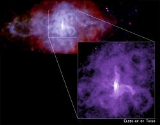
3C58
Encyclopedia
3C58 or 3C 58 is a pulsar
and surrounding synchrotron nebula within the Milky Way
that is possibly associated with the supernova
SN 1181
. There are, however, signs that indicate that it could be several thousand years old, and thus not associated with that supernova. http://simbad3.u-strasbg.fr/cgi-bin/cdsbib?2006ApJ...645.1180B
3C58 is notable for its very high rate of cooling which was unexplained by standard theories of neutron star formation. It is hypothesized that extreme conditions in the star's interior cause a high neutrino
flux, which carries away the energy and the star coolshttp://chandra.harvard.edu/photo/2004/3c58/.
It is located in the direction of Cassiopeia
and is estimated to be 10,000 light-year
s away.
3C58 has been proposed as a possible quark star
.
Pulsar
A pulsar is a highly magnetized, rotating neutron star that emits a beam of electromagnetic radiation. The radiation can only be observed when the beam of emission is pointing towards the Earth. This is called the lighthouse effect and gives rise to the pulsed nature that gives pulsars their name...
and surrounding synchrotron nebula within the Milky Way
Milky Way
The Milky Way is the galaxy that contains the Solar System. This name derives from its appearance as a dim un-resolved "milky" glowing band arching across the night sky...
that is possibly associated with the supernova
Supernova
A supernova is a stellar explosion that is more energetic than a nova. It is pronounced with the plural supernovae or supernovas. Supernovae are extremely luminous and cause a burst of radiation that often briefly outshines an entire galaxy, before fading from view over several weeks or months...
SN 1181
SN 1181
First observed between August 4 and August 6, 1181, Chinese and Japanese astronomers recorded the supernova now known as SN 1181 in eight separate texts....
. There are, however, signs that indicate that it could be several thousand years old, and thus not associated with that supernova. http://simbad3.u-strasbg.fr/cgi-bin/cdsbib?2006ApJ...645.1180B
3C58 is notable for its very high rate of cooling which was unexplained by standard theories of neutron star formation. It is hypothesized that extreme conditions in the star's interior cause a high neutrino
Neutrino
A neutrino is an electrically neutral, weakly interacting elementary subatomic particle with a half-integer spin, chirality and a disputed but small non-zero mass. It is able to pass through ordinary matter almost unaffected...
flux, which carries away the energy and the star coolshttp://chandra.harvard.edu/photo/2004/3c58/.
It is located in the direction of Cassiopeia
Cassiopeia (constellation)
Cassiopeia is a constellation in the northern sky, named after the vain queen Cassiopeia in Greek mythology, who boasted about her unrivalled beauty. Cassiopea was one of the 48 constellations listed by the 2nd century Greek astronomer Ptolemy, and it remains one of the 88 modern constellations today...
and is estimated to be 10,000 light-year
Light-year
A light-year, also light year or lightyear is a unit of length, equal to just under 10 trillion kilometres...
s away.
3C58 has been proposed as a possible quark star
Quark star
A quark star or strange star is a hypothetical type of exotic star composed of quark matter, or strange matter. These are ultra-dense phases of degenerate matter theorized to form inside particularly massive neutron stars....
.

